Being small succulents, Haworthias look great in pots. Many people grow them indoors to increase the visual interest of their interiors. When growing them indoors, you need to focus on the right type and size of pot so they can stay healthy until the time of repotting.
In general, a 3-5 inch terracotta or ceramic pot with drainage holes is ideal for a haworthia plant. The pot size will defer depending on the plant’s size and its root mass. The ideal pot should be one size bigger than your Haworthia as it would last for 2-3 years before the plant outgrows.
You can use different pot sizes depending on the plant and its roots. Today, we will talk about the ideal size for Haworthia, how to choose the right one and what else to consider for Haworthia pots.
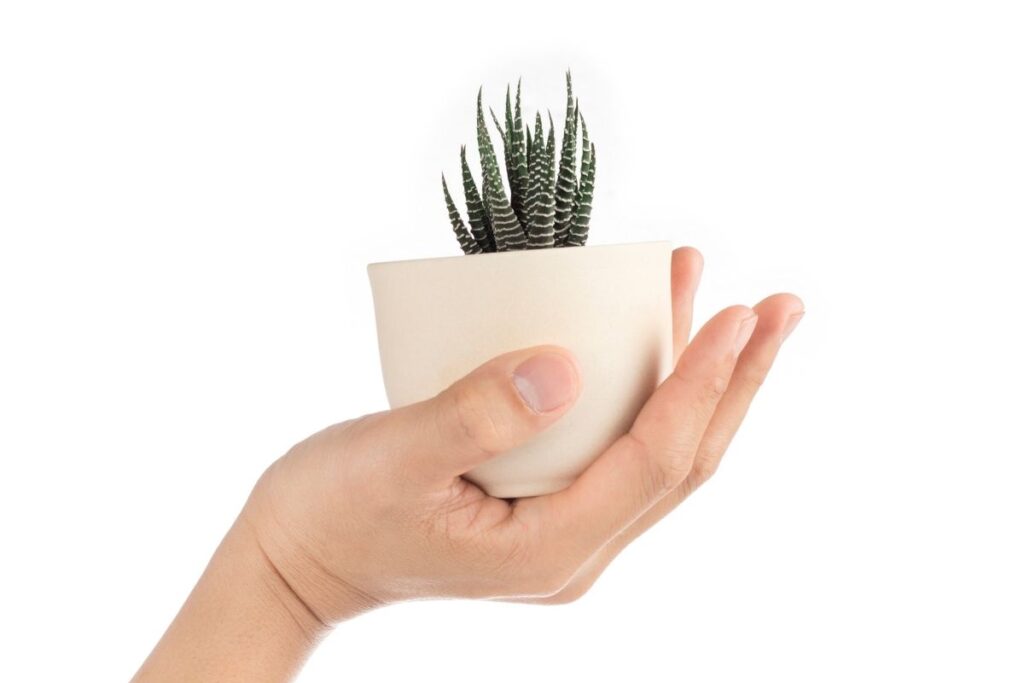
Why is it important to choose the right size of pot for Haworthia?
It is essential to put the Haworthias in the right-sized pots.
Planting Haworthias in the incorrect planter can weaken their health.
Moreover, their roots are fragile, and putting them in the wrong pot can result in root-bound or overwatering.
Both the conditions will hurt the roots and damage them.
Ultimately, the plant will end up dying.
Using too deep or shallow pot won’t let the roots absorb the water or nutrients properly or limit them from growing deep.
It will again affect the plant’s roots and result in stunted growth.
Haworthias have root hairs, and some varieties even have taproots.
The root hairs are small and resemble hairs.
They absorb the moisture for the plant from the dew or rainfall.
The taproot is the deep and main root that absorbs water from the soil, stores it, and slowly passes it to the plant.
So, keeping these in mind, you need to be careful while selecting the pot for them.
How will a small pot harm Haworthia?
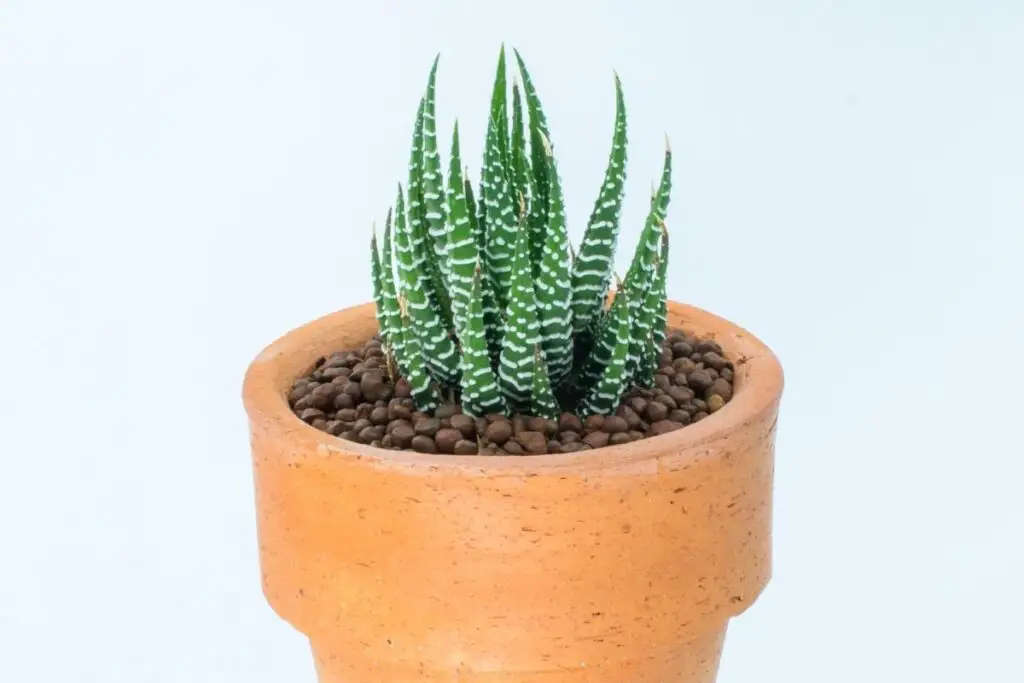
When you use a smaller pot than the plant’s size, it can harm its health in many ways.
Novice gardeners make this mistake because they think that Haworthia is a small succulent, and thus a small container would be enough to give the roots space to grow.
But that’s not true.
Ultimately they will outgrow and require space to grow.
Additionally, they will need space for their offsets.
A small pot requires very little soil.
As a result, the plant will get fewer nutrients than its usual requirement.
Due to this, the plant won’t grow strong and healthy.
A weak plant doesn’t live for many days and ultimately becomes prone to death.
Another result of using a small pot is root-bound.
A small planter won’t let the plant grow roots properly.
They won’t spread well and start growing in a circular motion.
This state is called root-bound.
If you constantly ignore them, there will be more roots than soil.
In such conditions, the plant might experience either overwatering or underwatering.
When you give them water, there is rarely any soil to absorb it.
So the water roams about around the roots and immediately drains out of the drainage holes.
Without soil, the plant fails to receive the water, thus staying dehydrated and under-watered.
When the roots don’t get enough space to grow, they start coming out of the soil surface and potholes.
Too many roots growing out of the hole will block the drainage holes at one point.
It fails to drain and stays in the container when you water them.
Due to this, the roots remain wet for a long time and thus suffer overwatering and root rot.
Looking for gardening supplies? We have tested 100's of products before recommending them to you guys. Check out our best pick below:
| Image | Gardening Supplies | Best Price? |
|---|---|---|
 Top
Top Top
Top | Raised Garden Bed Kit | Check On Amazon |
 | XLUX Soil Moisture Meter, Plant Water Monitor, Soil Hygrometer Sensor for Gardening, Farming, Indoor and Outdoor Plants, No Batteries Required | No Results |
 Top
Top Top
Top | 82 Pcs Garden Tools Set and Extra Succulent Tools Set | Check On Amazon |
 | Joeys Garden Expandable Garden Hose with 8 Function Hose Nozzle, Lightweight Anti-Kink Flexible Garden Hoses, Extra Strength Fabric with Double Latex Core, (50 FT, Black) | No Results |
 Top
Top Top
Top | Dual Chamber Compost Tumbler | Check On Amazon |
 Top
Top Top
Top | Sunnyglade Plant Stakes | Check On Amazon |
 Top
Top Top
Top | Organic Cold Pressed Neem Seed Oil | Check On Amazon |
 Top
Top Top
Top | Mighty Mint Gallon :-Insect and Pest Control Peppermint Oil | Check On Amazon |
 Top
Top Top
Top | Scotts DiseaseEx Lawn Fungicide | Check On Amazon |
 Top
Top Top
Top | Jacks Classic 20-20-20 All Purpose Fertilizer | Check On Amazon |
 Top
Top Top
Top | 30,000 Seeds Pollinator Attracting Wildflower Mixture | Check On Amazon |
 Top
Top Top
Top | Survival Vegetable Seeds Garden Kit-Over 16,000 Seeds | Check On Amazon |
What happens if you put Haworthias in a big pot?
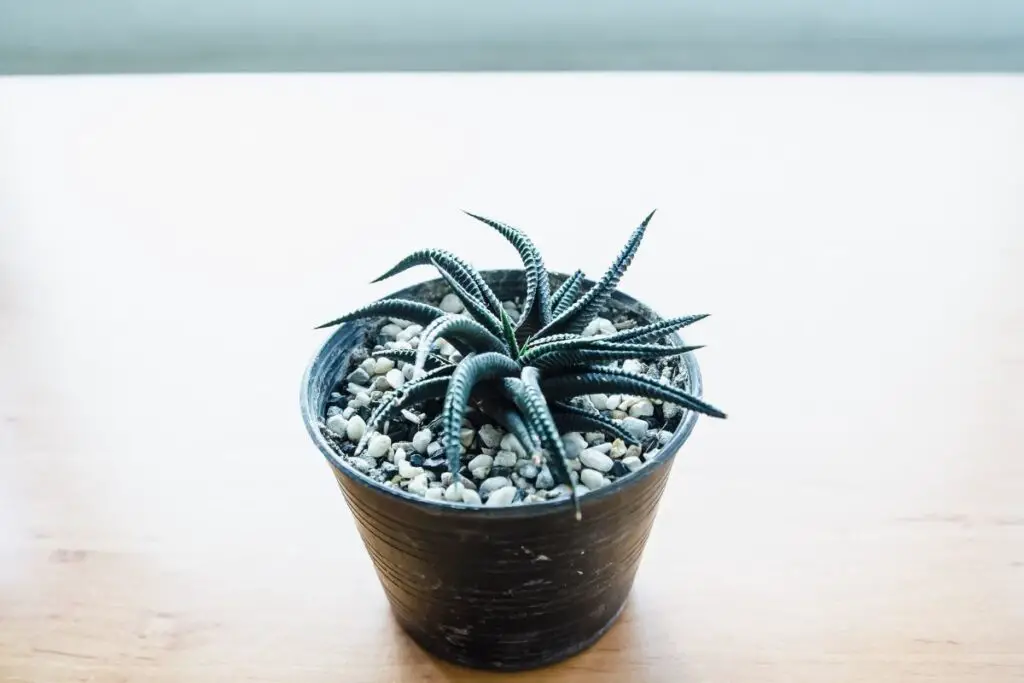
Similarly, a big pot is also harmful to this succulent.
Again, here too, beginners make this blunder because they think they give their succulents enough space to grow their roots.
Lots of soil is required to fill up a big pot.
Moreover, when you use a big pot, the succulent doesn’t fill the planter with its roots.
Due to more soil, it will take a long time to dry when you water the plant.
As a result, the roots will stay damp for a long and damage the roots.
The Haworthia roots must experience dry conditions because they are grown naturally.
If the roots don’t receive a dry environment, the roots will start rotting.
Since Haworthias are tender succulents and their fragile roots, they won’t tolerate any of the above two situations and become drastically weak.
If you continue ignoring the situation, the plant may end up dying.
How to choose the right size of pot for Haworthia?
While choosing the right size of the pot, you need to choose it with the right diameter and length.
It depends on the size of the plant and its roots.
A very deep container will need a lot of soil, like a big one.
This may not be good for the Haworthia type you own.
Some varieties have deep roots, and some have small roots.
Moreover, a deep pot will retain moisture like a big pot, thus causing rotting.
You need to select a pot that can fill it with the roots.
If you choose a container that is too shallow, then the roots might not fit in it.
If you still forcefully plant them, the roots will get folded at their ends and damaged.
So, to select an ideal pot, choose one that is 10% to 20% bigger than your plant in diameter and height.
For example, if your Haworthia measures 4 inches, you can use a pot that is 4.5 inches in diameter.
If your plant roots are between 2-3 inches, a pot with 3.10 inches in depth is ideal for them.
Using the right pot size gives the plant adequate space to grow roots and extra room for the offsets they produce once they mature.
For leaf cuttings, you must use a shallow container to plant multiple leaves in them.
Haworthias won’t require a pot larger than 5 to 6 inches.
If the plant needs a bigger container than this size for their babies, separate the offsets from their mother plant and plant them in a new pot.
Some ideal sizes of pot for Haworthias
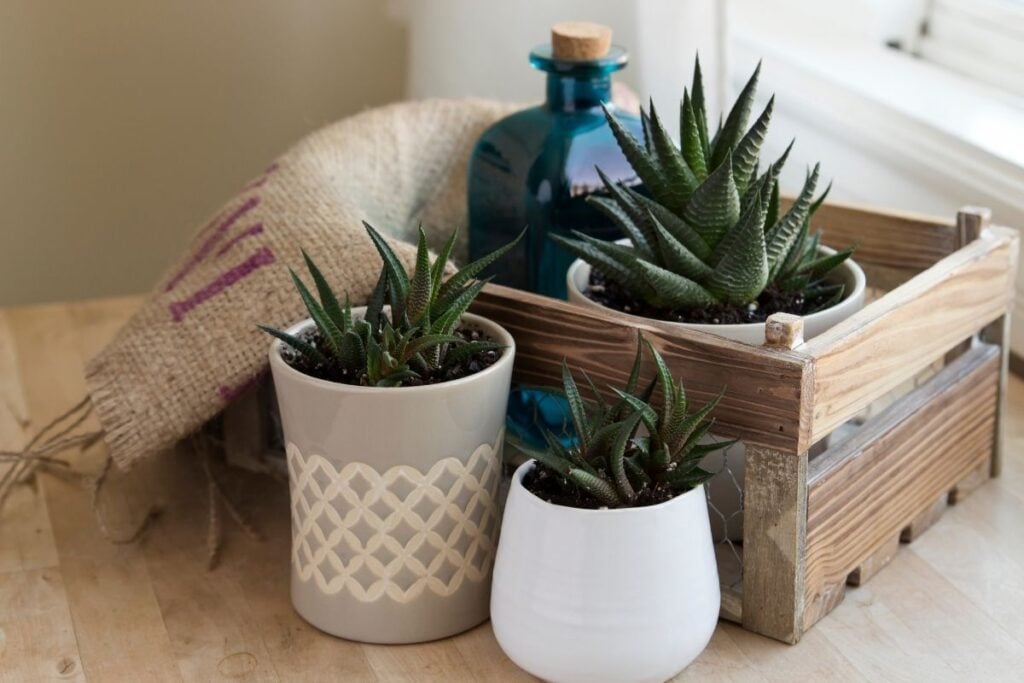
| Big Haworthia with long roots | Small Haworthia with deep roots | Big Haworthia with shallow roots | Haworthia seedlings |
|---|---|---|---|
| Length: 5.5 inches | Length or height: 4.3 inches | Length: 3.75 inches | Height: 3.10 inches |
| Surface diameter: 3.9 inches | Surface diameter: 3.3 inches | Top Surface diameter: 4.15 inches | Top surface diameter: 2.70 inches |
| Bottom diameter: 2.8 inches | Bottom diameter: 2.5 inches | Bottom surface diameter: 3.35 inches | Bottom surface diameter: 1.95 inches |
For placing leaf cuttings of Haworthias, you can use a big and shallow pot.
Once they produce offspring, you can shift them to another pot of ideal size.
For example, you can use a pot measuring 6 inches in diameter and 2-3 inches in depth.
If a container is too deep for the Haworthia roots, you can add some coarse materials at the base of the container to allow the deep growing medium to dry out quickly.
For example, you can add 6+ mm pumice.
It will sift out after placing the normal growing medium over it.
What else to look in for an ideal pot for Haworthia?
Other than the size of the container, two more things need to be considered:
- Drainage: The most important factor
- Pot material: Another way to save the plant from excess moisture.
Drainage
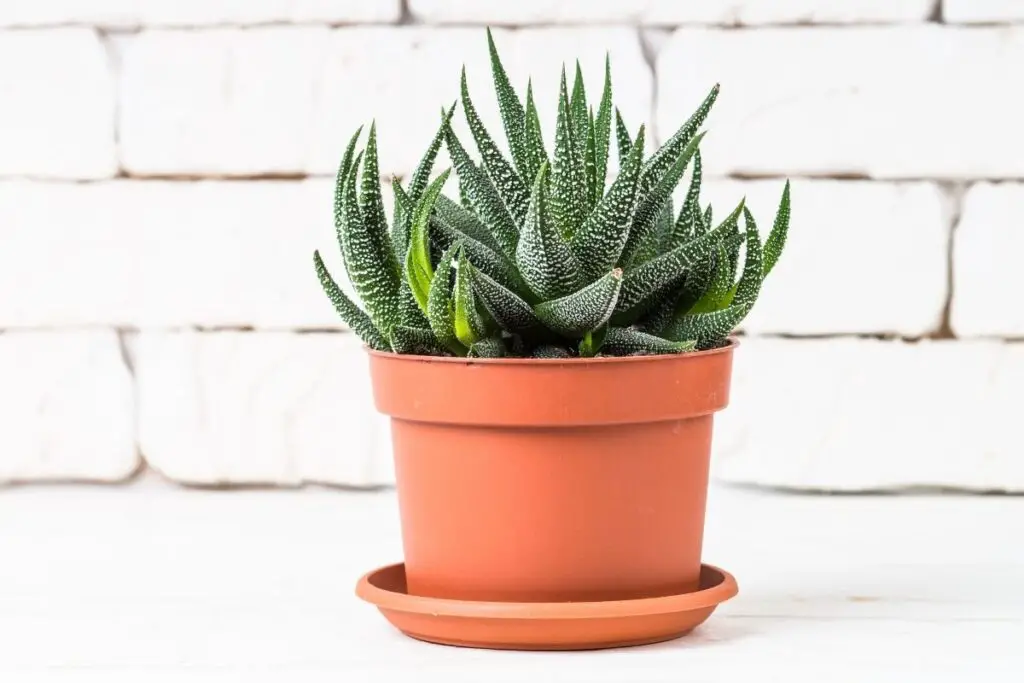
The first and foremost thing you need to check after the size is its drainage system.
A container must have drainage holes to drain the excess water from the pot.
If they don’t have one, the water will stay in the soil, make the roots wet for a long time, turn them soft and mushy, and eventually rot.
So, drainage holes are mandatory.
If there is no hole, you have to make one. Some decorative pots don’t have drainage holes because it may lessen their beauty.
You need to drill one if you want to save your plant.
There is another option: cachepot.
Put your plant in a cachepot with drainage holes and place it inside the decorative pot.
When it’s time for watering, take the cachepot out, water the plant, and wait until the excess water drains out.
Once they stop draining water, put the plant back in the decorative container.
Type of container
There are different pots available: terracotta, ceramic, wooden, plastic, and metal.
You can use any one of your choices.
You need to take care of them and check the plant’s and soil’s condition daily to check whether Haworthia is doing well in it.
Terra cotta is one of the best options out of all.
Terracotta pots are made of porous materials which can wick away moisture quickly.
If you water them frequently by mistake, the pot can wick away the excess moisture and save your plant from overwatering to some extent.
This pot is also ideal if you live in a humid climate.
On the contrary, a plastic pot is ideal if Haworthias don’t get enough moisture.
If you have the habit of underwatering, plastic pots can save you from it since they can hold moisture for a long time.
You should not let the full soil dry out.
A few inches from the bottom, the soil must stay moist.
The plastic pot won’t let the soil dry out fully between the watering.
So, if you ever forget to provide the plant water timely, it won’t mind.
Moreover, plastic pots are also good for Haworthia during dry climates.
You can use ceramic pots if you love decorative containers.
But you have to do what needs to be done here if they don’t have drainage holes.
Either drill one or use cachepots.
Though ceramics, terracotta, and plastic are mostly used due to their quality and looks, they can heat up quickly and make the soil too dry.
Plastic pots hold moisture for a little longer, but eventually, they will dry and brittle if slightly exposed to direct sun.
On the contrary, wooden pots are very good.
They will retain adequate moisture and keep the plant and the roots cool even under sunlight.
I would not suggest metal pots for Haworthias:
- They will heat up under the sun and dry the soil quickly.
- They can retain moisture for a long time. It can be risky if you overwater.
- Metals will develop rust at some point in time.
Can I grow multiple succulents in a single container?
Growing multiple succulents in one container can save your money from buying multiple pots for many succulents.
But it can be a tricky one.
To grow multiple succulents in one pot, you need to make sure all of them share the same requirements.
Along with Haworthia, you can grow those succulents that share the feature of Haworthias: indirect sunlight, frequent watering, spring and autumn growers, summer dormancy, average temperature, and low feeder.
Along with that, you need to choose an ideal-sized container so that you can keep enough space between each plant.
You need to estimate the space each plant will require to grow and produce offsets.
You can follow the same 10-20% rule here too.
For an approximate estimation, keep at least ½ to 1 inch of space between each plant.
Whenever you find any of them producing offsets, remove and transplant them from time to time.
This will avoid over-crowding.
When they grow actively in the spring and fall, they will fill up this space.
If they look too empty, you can also add some rocks to make the container look fuller.
Final words
Selecting a pot with a suitable size is very important for Haworthia and many other plants.
Along with the basic needs, the right kind of container also determines the plant’s health. It saves them from overwatering, underwatering, root-bound and stunted growth.
If you want to choose the correct pot for Haworthia, I hope this article will help you find the right one.
Ensure the drainage, right material, and size with the correct depth and diameter; whatever seems feasible.
Reference: The Haworthia Society, Botanical Studies, University of Wisconsin-Madison, Sciencedirect, Researchgate, Haworthia Study.
